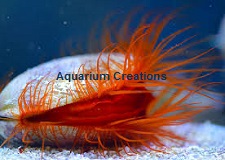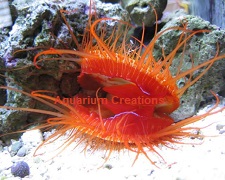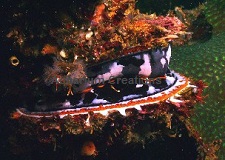Red Flame Scallop
Atlantic, Lima scabra

Description:
The Red Flame Scallop, also called the Red File Shell Clam, has a bright red mantel with red or white tentacles. Found in the Atlantic ocean only, The Red Flame Scallop uses its shell for protection, locomotion and feeding. By shutting its shell down it can protect itself either by hiding in the shell or by releasing a strong jet of water, which propels itself quickly through the water. The Flame Scallop will continue to move about via its water jet until it finds a suitable rocky area of the aquarium where it can extend and secure its foot. Flame Scallops are filter feeders and prefer an established aquarium that has sufficient calcium in order to allow their shell to grow.
Flame Scallops prefer to be housed in aquariums that have a good amount of live rock or rocky areas where the scallop can nest. It typically likes locations where it can embed itself between pieces of rock or coral and where water flow is moderately strong. In the aquarium it is important to remember that Flame Scallops can not be housed with any marine species that will pick at it or try to make it a meal. If attacked or bothered the Red Flame Scallop will move itself by ejecting water and using its tentacles to propel itself through the water.
The Flame Scallop is tolerant of all species that are non-threatening to it. It is a filter feeder therefore it requires floating phytoplankton and tiny zooplankton to be live in the aquarium. It is also important to provide proper calcium levels and alkalinity to keep its shell healthy. Water conditions must be excellent as this species will not tolerate nitrates or copper-based medications.
Diet and Feeding:
Unlike the popular giant clams (Tridacna Maxima's, Deresa's , etc.), scallops lack any photosynthetic symbionts to help with feeding itself. The scallops gain all their life giving energy through filtering tiny particles from the water around them. Items such as phytoplankton, baby brine shrimp and other organic foods or food mixes must be provided using a dropper or pipette. The food should be placed a few inches away from the scallop where the water current will take it to the scallop. If you have more than one scallop in your tank, each should be fed separately. For foods we recommend Two Little Fishes Marine Snow, AlgaGen PhycoPureT Reef Blend, AlgaGen Rotifers and Seachem Reef Phytoplankton.
Reef Compatibility:
Excellent will not harm inverts or corals
Level of Care:
Difficult because of the need for multiple feedings per day
Acclimaton Time:
1+ hours
Approximate Purchase Size:
2" to 3"
|
$15.00 each - 2 for $25.00
|
Electric Flame Scallop
Pacific, Lima Sp.

Description:
The Electric Flame Scallop, inhabits the waters of the Indo-Pacific, ranges in size from 1 inch to 3 inches and is instantly recognizable by its soft parts being a flame red color, with several bright red tentacles protruding from the open valves shell. What makes this Bivalve even more fascinating is that it seems to create bluish white electricity which can be seen shooting across the mantel like lightning bolts quite visibly in the dark. While the purpose of the Electricity generated by this species is unknown you can see the flicker of bluish electricity bolts flowing through the scallop's filaments.
The electricity (which is actually a form of bioluminescence) is not known to be harmful to other sea life, and especially since the electric flame scallop is a filter feeder and feeds off of microscopic phytoplankton and bacterioplankton (omnivorous) it is curious why it possesses such a brilliant ability. Marine Biologists answer this question by suggesting that the light generated by the electric scallop attracts plankton to its filament like moths to a flame, then the tentacles help it feed from its fixed location.
Often the Electric Flame Scallop is confused with its parent species the Flame Scallop or Lima Scabra which is also similar in appearance, with a red fleshy mantle covered with tentacles, except for the absence of the strip of bio-luminescent tissue on its mantle that sends a flash of color back and forth over the mantle.
Diet and Feeding:
Unlike the popular giant clams (Tridacna Maxima's, Deresa's , etc.), scallops lack any photosynthetic symbionts to help with feeding itself. The scallops gain all their life giving energy through filtering tiny particles from the water around them. Items such as phytoplankton, baby brine shrimp and other organic foods or food mixes must be provided using a dropper or pipette. The food should be placed a few inches away from the scallop where the water current will take it to the scallop. If you have more than one scallop in your tank, each should be fed separately. For foods we recommend Two Little Fishes Marine Snow, AlgaGen PhycoPureT Reef Blend, AlgaGen Rotifers and Seachem Reef Phytoplankton.
Reef Compatibility:
Excellent will not harm inverts or corals
Level of Care:
Difficult because of the need for multiple feedings per day
Approximate Purchase Size:
2" to 3"
|
$27.00 each - 2 for $50.00
|
Thorny Oyster
Spondyllus americanus

Description:
The Thorny Oyster is a beautiful addition to a reef aquarium. They can be found from 3 to 6 inches in size, are totally reef safe and will stay where placed in the aquarium. Despite the similar common name, the thorny oyster mollusc is more closely related to the scallop. Like scallops and file clams, they have a well developed middle mantle that carries sensory tentacles with multiple eyes around the shell edges. A unique clam found in the Caribbean Ocean are seen at depths of around 50 to 100 feet. With numerous spines which can grow up to 2 inches in length. Thorny Oysters come in a variety of colors (white, yellow, red and purple) which normally depends on the encrusting sponges and other marine life surrounding it.
Thorny Oyster are filter feeders which means that they have to be fed multiple times a day with planktonic foods. Even though they are in the scallop and clam family, they don't move around like flame scallops and stay at the selected spot. They like strong currents but are very sensitive to changes in salinity which requires a very slow drip acclimation. Thorny Oysters like lower light levels because of the depth in which they have been found. If all the conditions are right, they cement themselves to a rock and they can grow up to approximately 6 inches.
Diet and Feeding:
Unlike the popular giant clams (Tridacna Maxima's, Deresa's , etc.), the Thorny Oyster lacks any photosynthetic symbionts to help with feeding itself. The thorny oysters gain all their life giving energy through filtering tiny particles from the water around them. Items such as phytoplankton, baby brine shrimp and other organic foods or food mixes must be provided using a dropper or pipette. The food should be placed a few inches away where the water current will take it to the oyster. If you have more than one oyster in your tank, each should be fed separately. For foods we recommend Two Little Fishes Marine Snow, AlgaGen PhycoPureT Reef Blend, AlgaGen Rotifers and Seachem Reef Phytoplankton.
Reef Compatibility:
Excellent will not harm inverts or corals
Level of Care:
Difficult because of the need for multiple feedings per day
Approximate Purchase Size:
Medium 2" to 3" Large 3" to 4" XLarge 4" to 6"
|
Medium $59.99
Large $69.99
XLarge $89.99
|



